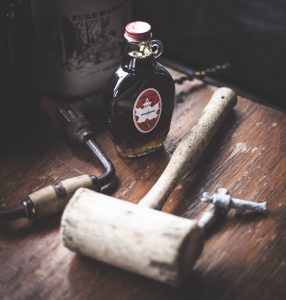Maple Tours at Covenant Harbor
Every February we’re watching the weather very closely. Like everyone else, we’re hoping it warms up… but only during the day. Warm days with freezing nights, we’ll take as many in a row as we can get. That’s when the sap runs.
As temperatures cool in autumn, all of our maples draw their sugar-rich sap inward, starving all their leaves, creating those beautiful colors. The maples stand almost dormant through the winter, sap locked deep in the cells. Usually in late February, when the cold gives way and the sun warms the trees, the pressure in the trunks changes and thawed sap is drawn up on its way to make millions of new leaves to collect energy from the sun. This is where we come in.
Throughout the winter while the trees were sleeping we will have been diligently cleaning tanks, inspecting and repairing equipment, and installing a complex spider web of tubes (maple lines), from one sugar maple to the next, all over our property. When the weather report says that first warm and sunny day is coming we go from tree to tree, drilling small holes into the outer layer of the trunks, just under the bark. We drive in small taps, connect them to our lines and watch as those first slow drips of sap start on their journey from tree to tube to tank. Sap runs all day and (if the weather cooperates) freezes again at night, slowing the tree’s progress sprouting buds. When buds sprout they take all the sugar and the sap becomes bitter, unsuitable for making syrup.
So while you’re looking at the weather report asking in despair why it can’t just get warm and stay warm already, I’m grinning and clapping my hands about another week of frozen nights.
If the sap is running well, we’re collecting more than 100 gallons per day – a drip at a time, just a little from each tree. We are careful to protect our trees from infection and we don’t over-tap. Many of our maples have been providing sap for decades. When that sap hits the tank we start a clock. Sugary sap must be cooked within a few days of collection or it will spoil, ruining any fresh sap in the tank with it. Ideally, we’ll have between 500-1000 gallons in storage before starting our first of many cooks. My favorite part.
To make sap into syrup, all you have to do is boil it… for a long time. Boiling sap reduces the water content and caramelizes the sugar at the same time. We cook our sap in a stainless steel evaporator built decades ago for just this purpose. Compared to industrial maple syrup producers, we’re a tiny operation, but when the evaporator is hot and boiling in our little maple shed, it seems pretty huge. Once we start a cook we don’t stop until it’s done. This almost always means cooking through the night in shifts.
The un-insulated shed fills up with sweet smelling steam, every surface beads up with water. And there you are, alone in the shed at 3am on a 30 degree night, plenty warm in a t-shirt and shorts, carefully monitoring levels and valves and flow rates, checking over and over to be sure it’s not time to draw off the next batch of fully cooked syrup before it over cooks. The evaporator is a cross between an enormous boiling pan and a maze. Sap flows in from an overhead tank, and passses through curves and zig-zags of copper and stainless, closed pipes and open pans. Through its journey, the sap loses water content and gains flavor and color until it reaches the end of its path and boils furiously in the final alley of the final pan until the sugar content is perfectly concentrated. All the while, fresh uncooked sap persistently ebbs in behind it.
On those long, solitary nights it’s easy to imagine you’re 100 years in the past. Everything is simple and mechanical. With the exception of one electric pump we use to make life a bit easier, gravity, heat, and time do all the work. Our job is watch and check…make sure everything we’ve assembled in the past months is doing its job. In the end we draw off huge pots of syrup to be pasteurized and bottled. Every gallon of syrup we produce has taken at least 40 gallons of sap (usually more), and who knows how much work pulling lines, drilling taps, emptying tanks, cooking, bottling, and cleaning.The work of making something natural and simple and rich, that people love, is joyus, we’re all made for it.
In addition to making syrup for you to buy and enjoy, we love to share about the people places and tools of our mapling process. Each spring we offer tours for groups. Come meet us in person, see how it’s done, and sample some syrup while standing in the shadow of the trees that made it. Email maple@covenantharbor.org or call 262-248-3600 for more information.
Blog Post By Brad Hutchison
